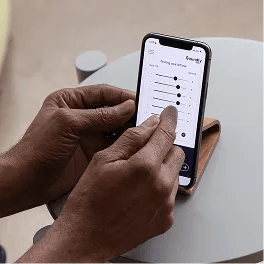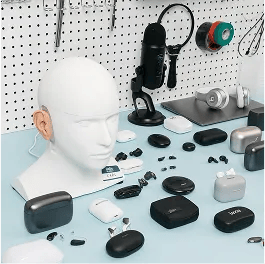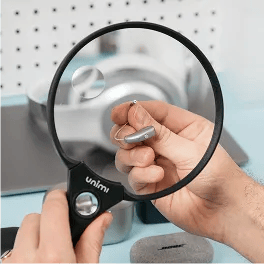When I got my first pair of hearing aids, I spent hours digging through the internet, convinced I was missing something. Why was it so hard to find real prices for hearing aids? Why didn’t any of the clinics list them online? And why did every site I visited feel like it was trying to sell me something?
Since then, I’ve spent thousands of hours researching hearing technology, testing products, and building this platform (Soundly.com) that helps people navigate this confusing space. In this guide, I’ll give you a clear overview of hearing aid pricing in 2025—whether you’re shopping OTC, visiting a local clinic, or somewhere in between.
Let’s start with the big picture.
A few terms to know:
- Hearing aid prices range from $99 to over $8,000 per pair, depending on the technology and care model.
- Over-the-counter (OTC) hearing aids start around $199 and are designed for adults with mild-to-moderate hearing loss.
- Prescription hearing aids purchased through a clinic usually include bundled services (testing, fitting, follow-ups) and average around $6,500 per pair.
- Telehealth and hybrid models fall in between, offering professional support at lower costs.
- Insurance rarely covers hearing aids, but there are exceptions and helpful workarounds like HSA/FSA dollars and state-specific programs.
- The right choice depends on your hearing loss, comfort with technology, and whether you want in-person support.
Prefer to Watch? 👇
Hearing Aid Price Chart
One of the biggest factors affecting hearing aid cost is the care model you choose. Fortunately, today’s hearing aid wearers have more options than ever. Here's a quick overview of the care models available and how they impact price.
1. OTC Hearing Aids
Over-the-counter devices became available in late 2022 after a major FDA ruling. They’re designed for adults with mild to moderate hearing loss and can be purchased via retailers like Soundly or in some stores like Walgreens—no hearing test or prescription required.
As a user, I’ve tested nearly every OTC option on the market. The best ones offer app-based controls, rechargeable batteries, and very strong sound performance. But they do require some independence and upfront research.
At Soundly, we currently offer just six OTC brands—out of dozens available—because they meet our quality standards. If you purchase through Soundly, you’ll get a guided setup call with an audiologist. Still, you’re the one pushing the buttons.
Typical brands: Sony, Sennheiser, Lexie B2+ Powered by Bose
Price: $199 – $999 per pair
Good fit for: Tech-comfortable users with mild/moderate loss (take our test here to determine your hearing loss level)
2. Telehealth + Hybrid Brands
These brands bridge the gap between OTC and traditional clinics. You typically start by taking a hearing test online or submitting one from your doctor, and then receive hearing aids through the mail with remote programming support. I’ve used services like this myself, and when done well, they can provide a great balance of affordability and care.
Typical brands: Audicus, Jabra Enhance Select, Eargo
Price: $1,200 – $2,650 per pair
Includes: Remote fitting, virtual support, app controls
Good fit for: Those who want programming support but don’t want to visit a clinic
3. In-Clinic Prescription Hearing Aids
This is the most traditional route—and the most expensive. When you visit a local audiologist, you’re paying for a full service bundle that includes diagnostic testing, device fitting, programming, and follow-up visits for a year or more. If you have complex hearing loss or want custom earmolds, this is usually the best path.
Typical brands: Phonak, Oticon, Widex, ReSound
Price: $3,500 – $7,500+ per pair (often includes all services)
Good fit for: Those with complex needs or who want in-person care
4. Costco and Big Box Retailers
Costco is the exception to many hearing aid rules. They offer a selection of prescription-level hearing aids at warehouse prices—often 30–50% lower than traditional clinics. You’ll still get in-person support, a hearing test, and fittings, but selection is more limited.
Typical brands: Philips, Jabra, Rexton
Price: $1,399 – $2,999 per pair
Good fit for: People near a Costco who want in-person care at a lower price
A Closer Look at In-Clinic Pricing
If you've ever tried to get a quote from a local hearing clinic, you might have noticed it's surprisingly difficult to find a clear number. Here’s why.
Unlike many consumer goods, hearing aids aren’t priced by the manufacturer. Instead, manufacturers sell devices to audiologists and hearing centers, who set their own prices—much like car dealerships. That means the same device might cost thousands more or less depending on where and how you buy it.
There are two big variables that impact what you’ll pay at a local clinic:
1. Care Network vs. Walk-In Pricing
Most people book an appointment with a local audiologist and are offered a full-service package. This typically includes:
- A hearing evaluation
- Device fitting and programming
- 2–3 years of follow-up appointments and cleanings
- Extra batteries or accessories
This “walk-in” price is commonly around $6,500 for a pair of premium-level hearing aids.
But there’s another option.
Companies like ZipHearing and AARP Hearing Solutions (powered by United Healthcare) have negotiated discounted rates with many of the same clinics. By referring patients in high volumes, they’re able to lower the upfront cost—often by 25%–40%—while still providing in-person care.
Here’s how it breaks down:
2. Technology Levels Within Each Brand
Another reason hearing aid pricing gets confusing: most manufacturers sell the same model at multiple technology tiers.
Let’s take ReSound as an example. Their flagship model (ReSound Vivia) comes in four different tech levels:
- Essential (good for quiet environments, fewer features)
- Entry Level (has some premium sound features by not all)
- Mid-level (adds more background noise reduction and programming channels)
- Premium (fully loaded, best for complex hearing loss and noisy settings)
This is similar to how a car might be sold in basic, midrange, and fully loaded trims—all under the same nameplate. At the same clinic, one patient might walk out paying $3,000 for a basic version, while another pays $7,000 for a top-tier model of the same device line.
So What Should You Do?
- Ask about technology levels. Don’t just ask for “a Phonak hearing aid”—ask which level (e.g. Infinio 30 vs 90). This requires some upfront research.
- Compare walk-in vs. network prices. If follow-up care is important to you, a full-service walk-in package might be worth it. If you’re more price-sensitive and comfortable with a bit of DIY care, network pricing from ZipHearing could save you thousands.
- Always request a detailed breakdown. Most clinics are happy to share what's included and what your options are—they just don't always lead with it.
Insurance, Financing, and Financial Assistance
Let’s talk about how to actually pay for hearing aids—because sticker shock is real - especially for prescription channels. While hearing aid prices can be high, there are ways to bring the cost down or spread it out over time. Here's a breakdown of the main options.
Health Insurance Coverage
Unfortunately, most private health insurance plans in the U.S. do not cover hearing aids for adults. That said, there are some important exceptions:
- Medicare (Parts A & B): Does not cover hearing aids or exams for fitting them.
- Medicare Advantage (Part C): Some plans offer partial coverage for hearing aids. Coverage varies widely, so check your plan or speak with your provider.
- Private Insurance: Certain employer-sponsored plans or state-regulated plans may cover part of the cost but coverage depends significantly on your plan and location.
- Medicaid: Coverage varies by state. Most states offer hearing aids for children, and some extend benefits to adults.
- State Mandates: States like New Hampshire, Arkansas, and New Jersey have laws requiring some level of hearing aid coverage. Check your state’s rules here.
Tip: Always ask your audiologist or hearing provider if they can help verify your insurance benefits before you buy.
Veterans Affairs (VA) Benefits
If you’re a U.S. military veteran, you may qualify for free hearing aids through the VA health benefits program.
- VA audiology services typically include testing, device fitting, and long-term support.
- Eligibility depends on your health status and service-connected hearing loss (but many veterans qualify regardless of direct injury).
Learn how to sign up for VA benefits here.
Nonprofit & Government Assistance
Several local and national programs offer free or discounted hearing aids to those who qualify:
- The Hearing Aid Project refurbishes donated hearing aids and distributes them to low-income individuals. They also provide a directory of state-by-state resources.
- Local Lions Clubs often provide financial assistance or connect individuals with partner programs.
- State assistive technology programs may offer loaner devices or grants.
Eligibility often depends on income level, age, or disability status—so check requirements or make a call to get started. Check out the Hearing Loss Association Of America's regularly updated list of resources here.
Financing Options
If you don’t qualify for coverage or aid, many hearing aid retailers and clinics offer financing to help make hearing aids more affordable.
- Financing is usually offered through third-party providers like CareCredit or Affirm.
- Be sure to ask about interest rates, repayment terms, and approval requirements.
- If you're buying through Soundly, you can access payment plans through Affirm starting at 0% APR.
Final Thoughts
We hope this guide has helped clarify your options and brought you closer to finding the right hearing aids—and the right care model—for your needs. If you’re just starting out, you might also enjoy our Beginner’s Guide to Hearing Aids, where we break down everything from styles to technology levels.
Getting hearing aids is a significant decision, but you don’t have to navigate it alone. Whether you have insurance, VA benefits, or need financial assistance, there’s likely a path that can make hearing care more accessible.
And if you have questions along the way, our team is here to help. Feel free to reach out anytime.






